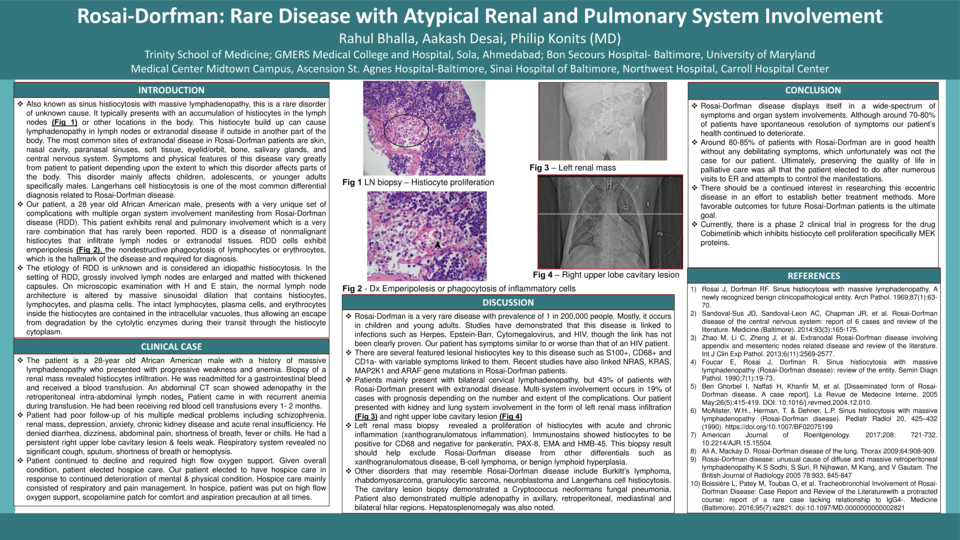Abstract
Also known as sinus histiocytosis with massive lymphadenopathy, this is a rare disorder of unknown cause. It typically presents with an accumulation of histiocytes in the lymph nodes or other locations in the body. This histiocyte build up can cause lymphadenopathy in lymph nodes or extranodal disease if outside in another part of the body. The most common sites of extranodal disease in Rosai-Dorfman patients are skin, nasal cavity, paranasal sinuses, soft tissue, eyelid/orbit, bone, salivary glands, and central nervous system. Symptoms and physical features of this disease vary greatly from patient to patient depending upon the extent to which this disorder affects parts of the body. This disorder mainly affects children, adolescents, or younger adults specifically males. Langerhans cell histiocytosis is one of the most common differential diagnosis related to Rosai-Dorfman disease. Our patient, a 28 year old African American male, presents with a very unique set of complications with multiple organ system involvement manifesting from Rosai-Dorfman disease (RDD). This patient exhibits renal and pulmonary involvement which is a very rare combination that has rarely been reported. RDD is a disease of nonmalignant histiocytes that infiltrate lymph nodes or extranodal tissues. RDD cells exhibit emperipolesis, the nondestructive phagocytosis of lymphocytes or erythrocytes, which is the hallmark of the disease and required for diagnosis. The etiology of RDD is unknown and is considered an idiopathic histiocytosis. In the setting of RDD, grossly involved lymph nodes are enlarged and matted with thickened capsules. On microscopic examination with H and E stain, the normal lymph node architecture is altered by massive sinusoidal dilation that contains histiocytes, lymphocytes, and plasma cells. The intact lymphocytes, plasma cells, and erythrocytes inside the histiocytes are contained in the intracellular vacuoles, thus allowing an escape from degradation by the cytolytic enzymes during their transit through the histiocyte cytoplasm. In addition to the histiocytic proliferation in the dilated sinusoids, reactive lymphoid follicles may be present in the cortex of the lymph node. Rosai-Dorfman disease displays itself in a wide-spectrum of symptoms and organ system involvements. Although around 70-80% of patients have spontaneous resolution of symptoms, our patient’s health continued to deteriorate. Around 80-85% of patients with Rosai-Dorfman are in good health without any debilitating symptoms, which unfortunately was not the case for our patient. Ultimately, preserving the quality of life in palliative care was all that the patient elected to do after numerous visits to ER and attempts to control the manifestations. There should be a continued interest in researching this eccentric disease in an effort to establish better treatment methods. More favorable outcomes for future Rosai-Dorfman patients is the ultimate goal.






